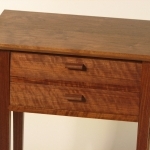Happy New Year All!
I am about to purchase a home with an existing detached shop. Im excited to getting out of a tight basement shop. The new shop has loads of space and natural light, HVAC and running water. Beneath the roof gable (which is probably like 22′) a previous owner added a drop ceiling…the kind of metal grid works with standard rectangular tiles/panels…like you see in offices building and/or schools. While its not the greatest looking shop ceiling it has a lot of advantages: sound dampening, tons of insulation above, and it is white and reflects the light nicely. And though it needs a bunch of new lighting fixtures…they should be easily swapped for the old fluorescents. I am planning to give the whole thing a nice, white coat of paint to repel dust. The question is how to hang dust collection duct work from it? I bought the nice nordfab steel piping for my 3hp oneida cyclone and so it isn’t a big deal to take it all apart and reassemble. Currently, in the basement shop it is running along the walls (floor joists above are super low) and around a couple of corners. I made my own hanger from galvanized strapping and some shop made plywood brackets–screwed to the joists above. To get the most of my new shop layout I am thinking a diagonal main trunk above head and some branches towards each side of the shop. But I have no idea what kind of hangers to use. How they would attach…to the grid? How much weight can those drop ceilings hold?
thanks for any knowledge you can share!
MK















Replies
What is the ceiling grid attached to? Can you support your dust pipes from the same structure that supports the grid?
You could cut small slots into the ceiling tiles to allow support straps/wires to penetrate.
Mike
Drop ceiling are not designed to hold additional weight. Do not hang your dust collection pipe from it. As Mike suggests, run hangers through the tiles to structural members above.
Yup, what those guys said. Run wires, hangers, or brackets through the ceiling tiles and attach them to structure above.
The Unistrut system will have hanger options if you want to get serious about it. They essentially use long all-thread rods to hang many things from ceilings. You see them used in many commercial buildings with exposed ceilings. You could use as much or little of the system as you see fit along with your own construction.
Thanks everyone this is sort of what I expected. Not relishing the thought of moving the insulation on top of the suspended ceiling, but some of the tiles need replacing anyway, so maybe those are the ones to modify for reaching through to the rafters or trusses.
MK
There is not a ton of weight to dust piping. I think if you find spots where the grid is hanging, usually 12 gauge wires bent on site secured with cable staples, you would be ok swapping out a few tiles for 3/8 plywood to hang the dust trunk from. My $0.02
Interesting idea...I was curious how robust the structure is inside a suspended ceiling, or how close together those hanger might be. the Nordfab quick fit isn't super heavy -- an 8" main trunk with a clamp at each end is about 22lbs.
Consider removing all the ceiling tiles (and marking them if needed) while you set up shop. After you finalize your tool footprint, then hang the DC ductwork from the exposed ceiling joist and add crossmember supports where needed.
Then replace all the tiles, custom cutting them as needed, to fit around the new ceiling layout.
I like that. Might as well hide the dust pipes in the ceiling entirely. Cut down on noise, too.
Also a neat, clean approach, but one of the beauties of the quick-fit clamp together duct work is that if I want to add a drop or branch or a machine, or move a tool to a different spot I can do so. Once its above the suspended ceiling that is a much bigger challenge.
interesting, but less work and materials to just run a wire hanger through a hole in the tile. Its the removing the tiles and disturbing the insulation about it that I am not excited about.
This forum post is now archived. Commenting has been disabled